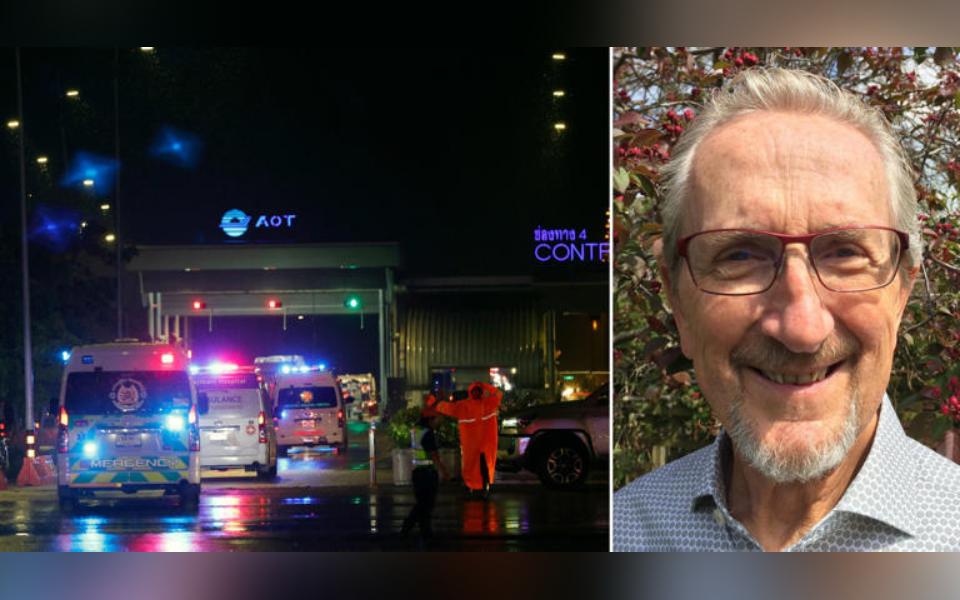Bangkok, May 21: A Singapore Airlines flight hit severe turbulence over the Indian Ocean and descended 6,000 feet (around 1,800 meters) in a span of about three minutes, the carrier said Tuesday, leaving a British man dead and more than two dozen other passengers injured.
The flight was then diverted and landed in stormy weather in Bangkok.
Authorities said the 73-year-old British man may have suffered a heart attack, though that hasn't been confirmed. His name wasn't immediately released.
The Boeing 777 flight from London's Heathrow airport to Singapore, with 211 passengers and 18 crew members aboard, landed at Bangkok's Suvarnabhumi Airport, the airline said in a Facebook post.
British passenger Andrew Davies told Sky News that “anyone who had a seatbelt on isn't injured."
He said that the seatbelt sign was illuminated, but crew members didn't have time to take their seats.
"Every single cabin crew person I saw was injured in some way or another, maybe with a gash on their head," Davies said. "One had a bad back, who was in obvious pain.”
Emergency medical crews rushed to help the passengers. Videos posted on the LINE messaging platform by Suvarnabhumi Airport showed a line of ambulances streaming to the scene.
Kittipong Kittikachorn, general manager of Suvarnabhumi Airport, told a news conference on Tuesday night that the British man appeared to have suffered a heart attack, but medical authorities would need to confirm that.
He said that seven passengers were severely injured, and 23 passengers and nine crew members had what he described as moderate injuries. Sixteen other people with less serious injuries received hospital treatment, while another 14 were treated at the airport, according to Kittipong.
Kittipong said the sudden descent happened as passengers were being served their food. It was Suvarnabhumi Airport's first time handling a midair turbulence related death, he added.
Thai airport authorities said that the passengers with minor injures, and those who are not injured, are being assisted at a specially assigned location inside the airport terminal.
Thailand's transport minister, Suriya Jungrungruangkit, said Singapore was dispatching another plane to transport those who could travel to the city-state's Changi airport.
Tracking data captured by FlightRadar24 and analyzed by The Associated Press show the Singapore Airlines flight SQ321 cruising at an altitude of 37,000 feet (11,300 meters).
At one point, the Boeing 777-300ER suddenly and sharply descends to 31,000 feet (9,400 meters) over the span of about three minutes, according to the data. The aircraft then stayed at 31,000 feet (9,400 meters) for under 10 minutes before diverting and landing in Bangkok less than a half-hour later.
The sharp descent in turbulence happened as the flight was over the Andaman Sea, near Myanmar. The aircraft sent a “squawk code” of 7700 at that time, an international emergency signal.
Details of the weather at the time weren't immediately revealed.
Most people associate turbulence with heavy storms. But the most dangerous type is so-called clear air turbulence. Wind shear can occur in wispy cirrus clouds or even in clear air near thunderstorms, as differences in temperature and pressure create powerful currents of fast-moving air.
The problem of turbulence was highlighted last December, when a total of 41 people on two separate flights hit by turbulence in the United States were hurt or received medical treatment on two consecutive days.
According to a 2021 report by the U.S. National Transportation Safety Board, turbulence accounted for 37.6% of all accidents on larger commercial airlines between 2009 and 2018. The Federal Aviation Administration, another U.S. government agency, said after the December incidents that there were 146 serious injuries from turbulence from 2009 to 2021.
Boeing, the maker of the Singapore Airlines plane that ran into turbulence , extended condolences to the family of the dead man and said it was “in contact with Singapore Airlines regarding flight SQ321 and stand ready to support them.”
The widebody Boeing 777 is a workhorse of the aviation industry, used mainly for long-haul flights by airlines around the world.
The 777-300ER variant of the twin-engine, two-aisle plane is larger and can carry more passengers than earlier models.
Singapore Airlines, the city-state's flag carrier, operates 22 of the aircraft as part of its fleet of more than 140 planes. The airline's parent company is majority owned by Singapore's Temasek government investment conglomerate, and also operates the budget airline Scoot.
Singapore Transport Minister Chee Hong Tat also extended condolences on his Facebook page. He said that his ministry and Singapore's Foreign Ministry, as well as the country's Civil Aviation Authority and Changi Airport officials, along with airline staff, “are providing support to the affected passengers and their families.”
The Transport Safety Investigation Bureau of the ministry said that it's investigating the incident and is in touch with its Thai counterpart and will be deploying investigators to Bangkok.
Singapore Airlines said that the nationalities of the passengers are: 56 Australians, two Canadians, one German, three Indians, two Indonesians, one from Iceland, four from Ireland, one Israeli, 16 Malaysians, two from Myanmar, 23 from New Zealand, five Filipinos, 41 from Singapore, one South Korean, two Spaniards, 47 from the United Kingdom and four from the United States.
Let the Truth be known. If you read VB and like VB, please be a VB Supporter and Help us deliver the Truth to one and all.
Kolkata (PTI): The police on Saturday arrested Satadru Datta, the prime organiser of the Lionel Messi football event at Salt Lake Stadium here, following widespread chaos at the venue, which prompted the Argentine World Cup-winning captain to leave the field early.
Taking suo motu cognisance of the stadium unrest, Datta was held by the Bidhannagar Police for “mismanagement” of the event from the Kolkata airport, where he had gone to see off Messi and his entourage on their way to Hyderabad.
"We are looking into whether there was any mismanagement from the organiser's side, which led to the chaos at the stadium. He has been detained, and the police have now brought the situation under control," West Bengal DGP Rajeev Kumar said at a press conference.
A senior police officer later confirmed that Dutta has been arrested. Till reports last received, the police were interrogating him and his manager inside one of the departure lounges of the airport.
The organiser has given in writing that he will refund the prices of tickets he sold to the disappointed spectators, Kumar said.
What was supposed to be a marquee football spectacle turned into widespread violence and disorder at the stadium after Messi’s brief and tightly ring-fenced appearance, his first at the venue since 2011, left large sections of the crowd frustrated, as they failed to catch a glimpse of their superstar despite having travelled from far and wide, paying hefty sums for tickets.
Police said they were also investigating how organisers allowed sale of bottled waters and beverages inside the stadium premises, which are banned items during such events.
Thousands of water bottles were used as missiles and lobbed inside the pitch by angry spectators, who also uprooted bucket seats from the gallery and used them as ammunition inside the field against the defending police and security personnel.
Spectators alleged that water bottles were being sold at a massive premium inside the stadium despite police disallowing such items from outside at the entry gates.
Police agreed there was an underlying tension in the galleries on account of Messi not showing his footballing skills on the field, which only got aggravated after a bunch of VIPs, including State Sports Minister Aroop Biswas and unidentified people, blocked the football icon’s view during the limited time he spent on the ground.
“We are on the job, and will ensure that whoever is responsible for what happened today at Salt Lake Stadium will be punished, and action will be taken against the authorities concerned,” said Jawed Shamim, ADG, Law and Order.





